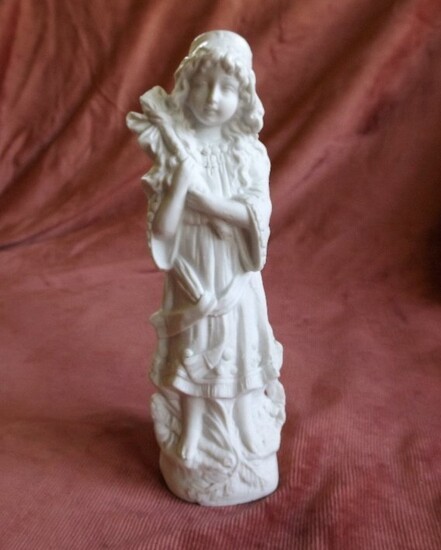Karl Unger, White Bisque Girl, Grafenthal 1870s Germany
Antique white porcelain Bisque Woman Figurine
"Poor Peasant Girl" figure, by Karl Unger, manufactured by the Unger and Schneider Porcelain Co., Grafenthal [Graefenthal].
The mark [logo without "DEP"] indicates that this figurine was manufactured in the period 1875-1878.
White translucent bisque, press mold [the joints are visible]; c 7.7/8" [20.8cm] tall x 2.3/4" [c. 7cm] wide, production number 7771; there is a small upper-surface crease which is not going through [there are no creases inside the figure]. Such creases may appear during the cooling process after the firing. Normally such 'creases' are hidden by glazes. However, this figure is an unglazed bisque. Some soiling, very good condition.
Based on a ducal concession, the businessman Carl Schneider (who had worked at the Wallendorf factory for some time) together with modelling artist Karl Unger and businessman Hermann Hutschenreuther founded their business in 1859. As Hutschenreuther was a silent partner, his name did not appear in the company name until 1885.
At first, the company only produced tableware, miniature sets for children and a few kitchen utensils, mostly decorated in cobalt blue 'Zwiebel-' [Blue Onion] and 'Strohblumenmuster' styles which sometimes included gilding. But unlike many other facilities they did not simply copy existing designs but rather used their own creativity. They started with export fairly early which was soon rewarded, as the first international award was received 1875 at the Exposicion Internacional de Chile (Santiago World Fair). The success also showed a problem, as the first marks that had been used, looked similar to the marks used earlier by the factory in Giesshuebel.
This lead to the introduction of the first mark that actually was used continuously, the impressed and uncrowned 'G' mark with the double-headed arrow which was used from 1875 onwards. Following the increasing popularity due to further awards during the Exposition Universelle (Paris World Fair) in 1878, it was decided to have the mark officially registered. The registration was filed on March 3rd 1879 at the Herzogliches Landgericht Graefenthal (Ducal District Court) and the first items showing the mark carrying the "DEP." addition were seen at the World Fair 1879 in Sydney, where the company yet again received an award for their products.
Rates vary per zone / country, we will adjust shipping costs with the invoice.
Note:
Country restrictions may apply - the lesser expansive Priority shipping may not be available to all countries.
US: Priority (c.2-4 days) ---------- $22.50
Canada: Priority (c.2-8 weeks) --- $45.50
World: Priority (c.2-8 weeks) ---- $66.50
View it on
Estimate
Time, Location
Auction House
Antique white porcelain Bisque Woman Figurine
"Poor Peasant Girl" figure, by Karl Unger, manufactured by the Unger and Schneider Porcelain Co., Grafenthal [Graefenthal].
The mark [logo without "DEP"] indicates that this figurine was manufactured in the period 1875-1878.
White translucent bisque, press mold [the joints are visible]; c 7.7/8" [20.8cm] tall x 2.3/4" [c. 7cm] wide, production number 7771; there is a small upper-surface crease which is not going through [there are no creases inside the figure]. Such creases may appear during the cooling process after the firing. Normally such 'creases' are hidden by glazes. However, this figure is an unglazed bisque. Some soiling, very good condition.
Based on a ducal concession, the businessman Carl Schneider (who had worked at the Wallendorf factory for some time) together with modelling artist Karl Unger and businessman Hermann Hutschenreuther founded their business in 1859. As Hutschenreuther was a silent partner, his name did not appear in the company name until 1885.
At first, the company only produced tableware, miniature sets for children and a few kitchen utensils, mostly decorated in cobalt blue 'Zwiebel-' [Blue Onion] and 'Strohblumenmuster' styles which sometimes included gilding. But unlike many other facilities they did not simply copy existing designs but rather used their own creativity. They started with export fairly early which was soon rewarded, as the first international award was received 1875 at the Exposicion Internacional de Chile (Santiago World Fair). The success also showed a problem, as the first marks that had been used, looked similar to the marks used earlier by the factory in Giesshuebel.
This lead to the introduction of the first mark that actually was used continuously, the impressed and uncrowned 'G' mark with the double-headed arrow which was used from 1875 onwards. Following the increasing popularity due to further awards during the Exposition Universelle (Paris World Fair) in 1878, it was decided to have the mark officially registered. The registration was filed on March 3rd 1879 at the Herzogliches Landgericht Graefenthal (Ducal District Court) and the first items showing the mark carrying the "DEP." addition were seen at the World Fair 1879 in Sydney, where the company yet again received an award for their products.
Rates vary per zone / country, we will adjust shipping costs with the invoice.
Note:
Country restrictions may apply - the lesser expansive Priority shipping may not be available to all countries.
US: Priority (c.2-4 days) ---------- $22.50
Canada: Priority (c.2-8 weeks) --- $45.50
World: Priority (c.2-8 weeks) ---- $66.50



